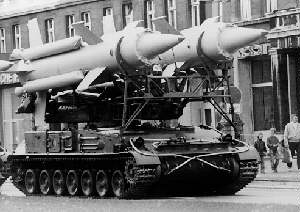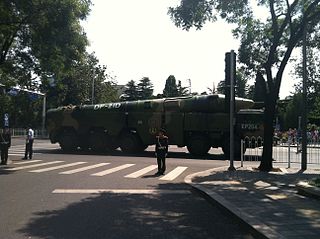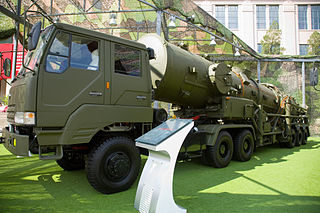
An intercontinental ballistic missile (ICBM) is a ballistic missile with a range greater than 5,500 kilometres (3,400 mi), primarily designed for nuclear weapons delivery. Conventional, chemical, and biological weapons can also be delivered with varying effectiveness, but have never been deployed on ICBMs. Most modern designs support multiple independently targetable reentry vehicle (MIRVs), allowing a single missile to carry several warheads, each of which can strike a different target. Russia, the United States, China, France, India, the United Kingdom, Israel, and North Korea are the only countries known to have operational ICBMs.

The Dongfeng series, typically abbreviated as "DF missiles", are a family of short, medium, intermediate-range and intercontinental ballistic missiles operated by the Chinese People's Liberation Army Rocket Force.

A transporter erector launcher (TEL) is a missile vehicle with an integrated tractor unit that can carry, elevate to a firing position and launch one or more missiles.

The People's Liberation Army Rocket Force, formerly the Second Artillery Corps, is the strategic and tactical missile force of the People's Republic of China. The PLARF is the 4th branch of the People's Liberation Army (PLA) and controls China's arsenal of land-based ballistic missiles—both nuclear and conventional. The armed service branch was established on 1 July 1966 and made its first public appearance on 1 October 1984. The headquarters for operations is located at Qinghe, Beijing. The PLARF is under the direct command of the Chinese Communist Party's Central Military Commission (CMC).

The Dong Feng 31 is a third-generation long-range, road-mobile, three stage, solid-fuel rocket intercontinental ballistic missile (ICBM) in the Dongfeng missile series developed by the People's Republic of China. It is designed to carry a single 1-megaton thermonuclear weapon. It is a land-based variant of the submarine-launched JL-2. It is operated by the Second Artillery Corps (SAC) which, in 2009, was estimated to have under 15 DF-31 missiles and under 15 DF-31A missiles in inventory. US Air Force National Air and Space Intelligence Center estimates that as of June 2017, five to ten Mod 1 and over fifteen Mod 2 launchers were operationally deployed.

An air-launched ballistic missile or ALBM is a ballistic missile launched from an aircraft. An ALBM allows the launch aircraft to stand off at long distances from its target, keeping it well outside the range of defensive weapons like anti-aircraft missiles and interceptor aircraft. Historically, once launched the missile was essentially immune to interception due to a lack of capable anti-ballistic missiles, with those few that did exist being limited to known static positions. This combination of features allowed a strategic bomber to present a credible deterrent second-strike option in an era when improving anti-aircraft defences appeared to be rendering conventional bombers obsolete. However, by the 1990's surface-to-air missile technology had innovated to the point of allowing the interception of such weapons from road mobile systems, albeit at a lower PoK. By the early 21st century capable, dedicated, ABM systems from several nations had been deployed in significant numbers, spurring further innovation in hypersonic glide vehicles to penetrate such systems and keep ballistic missiles capable.

The TAIAN TA580/TAS5380 is a 20-ton 8x8 special heavy duty truck developed and built by Taian Special Vehicle Manufactory and used by the People's Liberation Army of the People's Republic of China as a transport/Transporter erector launcher.

The WS2400 is a 8x8 special heavy-duty truck developed and built by Wanshan Special Vehicle and used by the People's Liberation Army of the People's Republic of China as a transporter erector launcher (TEL) platform and is a reverse engineered version of the MAZ-543 missile Transporter erector launcher.

The WS2500 is a 20-ton 10x10 special heavy duty truck used by the People's Liberation Army of the People's Republic of China. It is one of the principal mobility platforms in mounting China's medium-range ballistic missiles and other conventional missile assets.
The Dongfeng-41 or DF-41 is a fourth-generation Chinese solid-fuelled road-mobile intercontinental ballistic missile operated by the People's Liberation Army Rocket Force. DF-41 is the fourth and the latest generation of the Dongfeng series strategic missiles developed by China. The missile was officially unveiled at the China National Day military parade on 1 October 2019.
The Hwasong-13, also known as Nodong-C or KN-08 under the U.S. naming convention, is a road-mobile intercontinental ballistic missile believed to be under development by North Korea. The changes shown in the mock-up displayed in October 2015 indicated a change from a three to two-stage design.

The WS51200 is an extremely large and heavy transporter erector launcher built by Wanshan Special Vehicle in China. The WS51200 is one of the largest in the WS family of transport trucks and TELs. The size of the WS51200 allows it to carry intercontinental ballistic missiles.
The Hwasong-15 is an intercontinental ballistic missile developed by North Korea. It had its maiden flight on 28 November 2017, around 3 a.m. local time. It is the first ballistic missile developed by North Korea that is theoretically capable of reaching all of the United States' mainland.

The TAIAN TA5450/TAS5450 is a 25 ton transporter erector launcher that primarily carries ballistic missiles. However, it is also able to carry other weapon systems such as rockets and conventional missiles. Despite sometimes being called the TA5450, the actual official designation of the vehicle is the TAS5450. The TA5450 is actually the designation of the vehicle's base chassis, while the TAS5450 refers to the vehicle itself.

The Taian HTF5680A1 is a large transporter erector launcher with a 12x12 configuration. The vehicle comes in two primary variants. The conventional HTF5680 is a 12x12 flatbed vehicle for transport purposes. However, the most common and famous variant is the HTF5680A1 which carries ballistic missiles, most famously, the DF-26 intermediate-range ballistic missile.

The WS2600 is a 22.5 ton 10x10 transporter erector launcher used by the People's Liberation Army Rocket Force of the People's Republic of China. It is, along with the smaller WS2500, one of the principal mobility platforms in mounting China's medium-range ballistic missiles.

The Hanyang HY4260 is a model of military tractor trucks developed, produced and used by the People's Republic of China. These vehicles are primarily used to mount Beijing's ballistic missile family and are used in conjunction with other transporter erector launchers, to further bolster China's ballistic missile capabilities.

The Hanyang HY4330 is a large model of military tractor trucks developed and produced by the Hanyang Special Purpose Vehicle Institute, which in turn is used by the People's Republic of China. These trucks behave essentially like conventional transporter erector launchers and as such, are used primarily to offer Beijing second strike nuclear capabilities; bolstering China's ballistic missile capabilities.
The WS21200 is a large transporter erector launcher built and developed in the People's Republic of China. Like the WS51200, the WS21200 is not actually used by the People's Liberation Army Rocket Force, instead, the primary customer is Pakistan. The WS21200 along with the WS51200, is one of the larger TELs developed by the Wanshan Special Vehicle.














